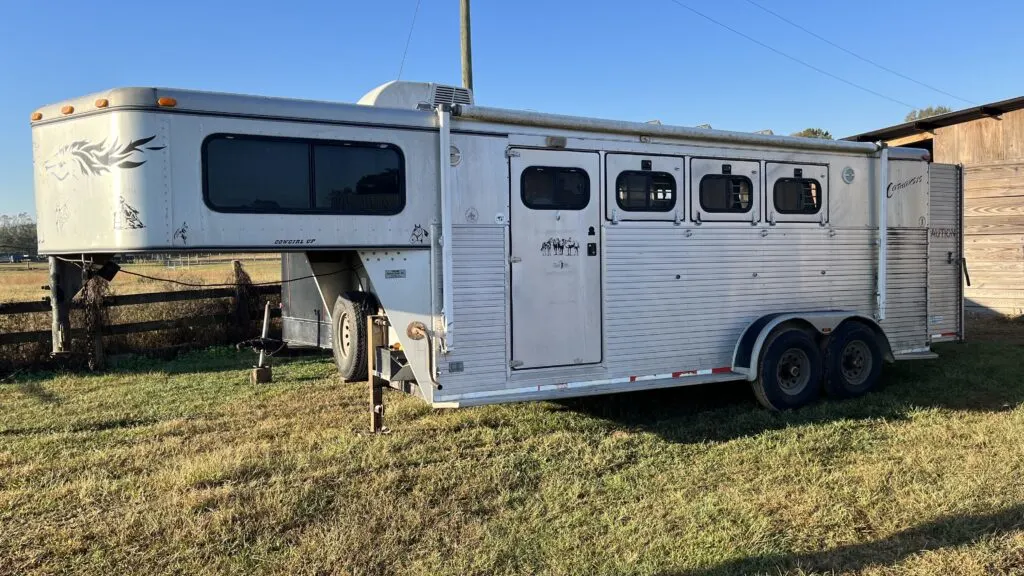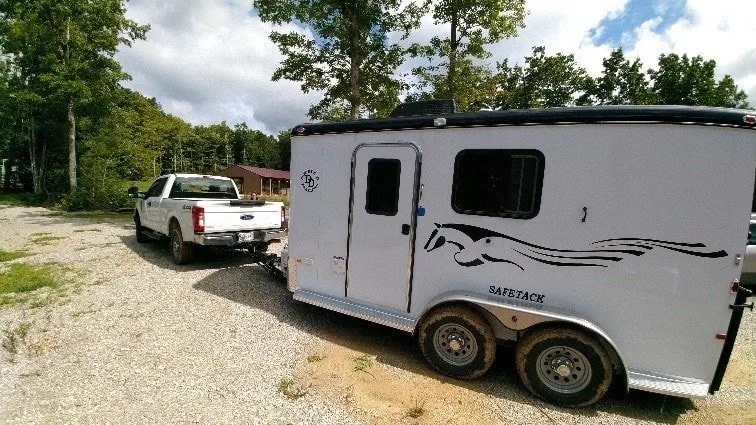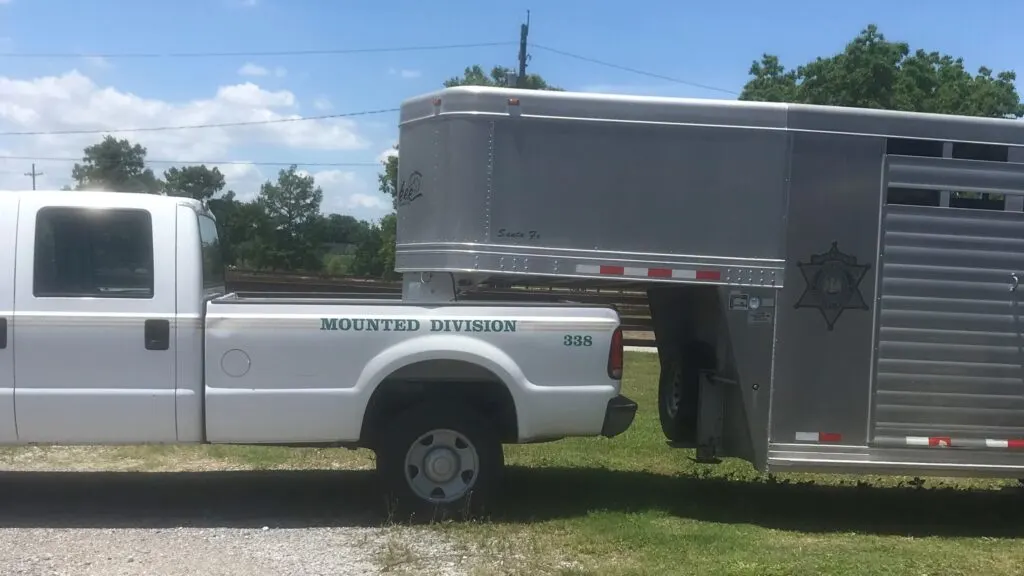Last updated: February 17, 2023
Any links on this page that lead to products on Amazon are affiliate links and I earn a commission if you make a purchase. Thanks in advance – I really appreciate it!
It can be pretty hard to back up a horse trailer the first few times. Driving a trailer is not like driving a regular vehicle. If you don’t know what you’re doing, you can quickly get stuck in a tight spot or bang up your trailer. So I wanted to share some tips and tricks I learned to make backing up a horse trailer easy.
To back up a horse trailer, grip the steering wheel at the bottom, and put your tow vehicle in reverse. Keep an eye on the trailer from your side mirrors and when maneuvering it, move the steering wheel slow and steady and, if possible, turn towards the driver’s side.
Many people are excellent drivers pulling a trailer forward. Still, they have a hard time backing with a trailer because they lack basic knowledge like the correct angle of the mirrors, hand placement, and ways to avoid jackknifing. This article covers what you need to know to back a horse trailer like a pro.
Why is backing up a trailer so hard?
Backing up a horse trailer can be frustrating; essentially, you have to control two different vehicles and be mindful of the unpowered trailer movements related to the towing vehicles’.

When you back up a trailer, you need to know how the steering wheel’s rotation affects the front and rear. Using the mirrors to correctly determine how much the back of the trailer has turned is also critical. You also have to move your torso sideways to see the passenger’s side mirror.
When backing up a trailer, you might run into a common problem called jackknifing. Jackknifing describes a trailer and truck position that ends up in a position resembling a pocket knife opened halfway.
You get in this awkward position when you try to back up too quickly, and the trailer’s rear turns too much in either direction. If you have to back up a trailer in traffic, you need to watch the front of your vehicle to make sure you can maneuver without hitting anything.
When I started pulling our four-horse gooseneck trailer, it took me a few weeks to get the hang of backing up without making mistakes.
Here is a YouTube video that provides some helpful information about backing up trailers.
Tips and tricks to easily back up a trailer
- Learn to rely on the wing mirrors entirely. For instance, if you are backing up in a straight line, the trailer’s rear should appear stationary in either of the mirrors.
- Place your hand at the bottom of the steering wheel when backing up; that way, the trailer’s rear turns in the same direction your hand goes.
- If the trailer appears in one mirror more than the other, and your hands are at the bottom of the steering wheel, steer away from that mirror to straighten up the trailer.
- If you aren’t positive you can back up a trailer alone, never hesitate to ask someone to give directions.
- Using a rear camera system can make backing up much easier.
- If you have a gooseneck trailer attached to a short bed truck, be careful that the trailer’s front doesn’t hit your vehicle’s rear window.
- Don’t turn too fast or too sharply to prevent the trailer from jackknifing.
- The longer the trailer, the more time it will take for the trailer’s rear to turn after you’ve turned the wheel.
- Don’t forget to watch the vehicle’s front, especially if you are in a tight space.
- Practice backing up and making sharp turns in an open area until you get the hang of it.
- When possible, make turns towards the driver’s side. This way, you won’t have to move your body to look at the right-side mirror. You can just look out the driver’s side window and see the trailer when backing.
When you travel with horses, you must carry extras like water, emergency kits, medical kits for horses, and other equine-related essentials. To read more, check out my article on 5 essentials for horse trailers.

When backing up a trailer, which body position should you be in?
Maintaining the correct body position can make backing a horse trailer much easier. I suggest sitting up straight and using your wing mirrors whenever backing. From this position, you should be able to see both mirrors without moving your body much.
If you don’t have a good view from your mirrors, you may need to adjust the mirrors or your seat height. And you should have enough room in the truck cab to move a few inches to the passenger side.
Drivers often use their center rearview mirror when reversing with a standard utility trailer because it provides a better visual of what’s behind you and what kind of turns to make.
When pulling a horse trailer, using rearview mirrors isn’t an option because your horse trailer obstructs it. And depending on the size of your truck and trailer, you may not be able to see anything out of your back window either. To be proficient in backing a horse trailer, you must learn to rely on your side mirrors.
Important note: Be conscious of your trailer’s height when backing it up because many horse trailers are tall and are at risk of hitting overhead wires or limbs.

How to adjust and use your side mirrors when backing up a trailer.
Many people run into problems when backing up a trailer because they didn’t correctly adjust their mirrors before backing. Adjusting and using the side wing mirrors isn’t much different from using a regular vehicle’s mirrors.
To find the correct position of the driver’s side wing mirror, move your head close to the left window and adjust the mirror so that the truck’s rear corner is visible in the inside edges of the mirror.
To position, the passenger’s side mirror, move your head so it’s opposite the center of the console, and adjust the mirror just like you changed the other one.
If you want to back up your trailer in a straight line, just make sure that either truck’s corners remain stationary in the wing mirrors.
Where should your hand be when backing up a trailer?
It helps to place your hand at the same spot on the wheel every time you back up a trailer. When I first started backing a trailer, I thought of the wheel as moving either clockwise or counterclockwise.
This thinking led to many goof-ups, so I changed my thought process and began backing up like a pro. First, clear your mind and place your hand at the bottom of the steering wheel.
Next, rotate your wheel so the tires are straight, facing forward, and put the vehicle in reverse. As you are backing up, your trailer’s rear will turn in the direction where you rotate the wheel. (Check out the video below)
When you’re reversing a regular vehicle, the rear turns, in the same way, the top of your wheel turns. However, the opposite is true when driving a trailer, so when you rotate the top of your wheel left or right, the rear of the trailer turns in the opposite direction.
To quickly get accustomed to this method, always start with your hands in the same position, move slowly backward, and avoid abrupt hard turns.

What should you do if the trailer starts to jackknife while backing up?
Jackknifing happens when the trailer uncontrollably turns at an angle less than 90 degrees and comes dangerously close to the towing vehicle. It can cause severe damage to your trailer and result in accidents when you are on the road.
If the trailer starts to jackknife while backing up, apply the trailer’s brakes and avoid making any sharp turns. Try to stabilize the vehicle by steadily turning the wheel opposite to the skidding of the trailer. Once the trailer has stopped, you can straighten it up by driving forward.
Jackknifing is particularly dangerous when it occurs at high speed. Therefore, it is always recommended to back up your trailer slowly. If you are backing up in a straight line and have to take a turn, use the brakes before doing so.

Backing up a gooseneck vs. bumper pull trailer for horses.
The primary difference between a gooseneck and bumper-pull horse trailer is how they connect to its towing vehicle. Gooseneck trailers hook to a ball hitch mounted in a truck bed, and a bumper-pull attaches to a tow hitch mounted below the bumper of a vehicle.
Because gooseneck trailers hitch to a ball in a truck bed, they are easier to maneuver and back up than a bumper-pull horse trailer. Gooseneck trailers also allow you to make sharp turns going backward or forwards.
Several other differences exist between a gooseneck and a bumper pull horse trailer. Before you buy one, it’s worth learning which one will serve best for your purpose.
Goosenecks are generally larger than bumper pulls and more stable. Because the hitch is in the truck’s bed, the horse’s and the trailer’s weight is more evenly spread across the vehicle.
With a bumper pull horse trailer, all the weight is on the rear of the vehicle, which can cause instability. To combat this, many people use a weight-distribution hitching system.
Large bumper pull trailers can hold up to four horses. However, any more than two horses can make the trailer heavy and challenging to manage.
Bumper pull trailers are also less expensive and can be towed by small vehicles like a small truck or an SUV because they don’t need an open bed to place a hitching ball.
Goosenecks are typically heavy, and large models can easily hold up to seven or eight horses. However, if you tow a large gooseneck, you’d need to drive a full-sized truck which can be expensive.
FAQ
Do horse trailers have to stop at weigh stations?
Each state has its own regulations, but if your tow vehicle and horse trailer’s combined weight is over 10,001 lbs, you likely are required to stop at weigh stations. But the best practice is to check the law in every state you plan to travel to.
Is it difficult to hook up a bumper-pull horse trailer?
It’s not difficult to hook up a bumper-pull horse trailer; you just need to follow a few easy steps. First, line up the hitch and ball, crank the trailer hitch down on the ball and secure it with the safety clip, hook up the safety chains, plug in the lights, and you’re ready to go.
Before taking off, check that the lights are operating properly and double-check the safety hitch clip and chains. For more information about pulling a bumper-pull horse trailer, check out this article: Towing A Two-Horse Bumper Pull Trailer: All You Need To Know.
Meet Miles Henry
An avid equestrian and seasoned racehorse owner, Miles Henry brings his extensive experience to the equine world, proudly associating with the AQHA, The Jockey Club, and various other equine organizations. Beyond the racetrack, Miles is an accomplished author, having published various books about horses, and is a recognized authority in the field, with his work cited in multiple publications.
🔗 Connect with Miles:
Twitter
Facebook
YouTube: Check out race highlights, horse care tips, and more!

